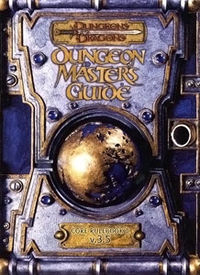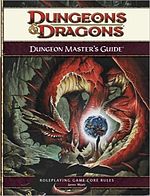- Dungeon Master's Guide
-
Dungeon Master's Guide 3.5 
Cover of the v3.5 Dungeon Master's GuideAuthor(s) Monte Cook, Jonathan Tweet, and Skip Williams Genre(s) Role-playing game Publisher Wizards of the Coast Publication date July 2003 Media type Print (Hardback) Pages 320 ISBN 0-7869-2889-1 OCLC Number 52691405 LC Classification GV1469.62.D84 D836 2000 The Dungeon Master's Guide (DMG[1] or DM's Guide; in earlier editions, the Dungeon Masters Guide or Dungeon Master Guide) is a book of rules for the fantasy role-playing game Dungeons & Dragons. The Dungeon Master's Guide contains rules concerning the arbitration and administration of a game, and is intended for use primarily or only by the game's Dungeon Master.[2] The original Dungeon Master's Guide was published in 1979,[3] and gave Dungeon Masters everything they needed to run a D&D game campaign.[1]
It is intended as a companion book to the Player's Handbook, which contains all of the basic rules of gameplay, and the Monster Manual, which is a reference book giving statistics and characteristics to various animals and monsters. The Player's Handbook, Dungeon Master's Guide, and Monster Manual are collectively referred to as the "core rules" of the Dungeons & Dragons game.[4] Both the Dungeon Master's Guide and the Player's Handbook give advice, tips, and suggestions for various styles of play.[5]
While all players, including the Dungeon Master, are expected to have at their disposal a copy of the Player's Handbook, only the Dungeon Master is expected to refer to the Dungeon Master's Guide or Monster Manual during gameplay.[6]
Contents
Advanced Dungeons & Dragons
The original Dungeon Masters Guide (sic) was written by Gary Gygax, and published by TSR in 1979 as a 232-page hardcover with a cover by David C. Sutherland III.[7] The 1983 printing featured a new cover by Jeff Easley.[7]
Like other volumes of Dungeons & Dragons handbooks, the Dungeon Master's Guide has gone through several versions through the years. The original edition was written by Gary Gygax and edited by Mike Carr, who also wrote the foreword. The original cover art was by D. A. Trampier, and interior illustrations were provided by David C. Sutherland III, Trampier, Darlene Pekul, Will McLean, David S. LaForce, and Erol Otus.
The first edition Dungeon Masters Guide covered all the essential rules for the Dungeon Master: creating and maintaining player characters and managing non-player characters, handling combat, and running adventures and multi-session campaigns.[7] The book also included descriptions of magic items and treasure, random monster encounters, and statistics for the basic monsters and creatures of the game.[7]
The Dungeon Master's Guide contains scores of tables and charts for figuring damage and resolving encounters in a typical adventure, tables and rules for creating characters, and lists of the various abilities of the different classes of characters.
One supplement to the Guide was the Dungeon Master's Screen: two heavy-duty tri-fold boards with the most frequently used tables printed on them for easy reference. The 1979 second edition of the screen describes its purpose as "useful for shielding maps and other game materials from the players when placed upright, and also provide[s] instant reference to the charts and tables most commonly used during play." The Advanced Dungeons & Dragons Second Edition screen came packaged with a brief adventure; later editions of that screen, and screens produced for later editions, have instead included character sheets and general reference booklets.
A feature of the first edition Dungeon Masters Guide was the random dungeon generator. The generator allowed the Dungeon Master, by the rolling of dice, to generate a dungeon adventure "on the fly". A dungeon complete with passageways, rooms, treasure, monsters, and other encounters could easily and randomly be constructed as the player progressed. It could be used with several people or a single player. The generator was not included in the subsequent editions of the Dungeon Master's Guide.
The original Dungeon Masters Guide was reviewed by Don Turnbull in issue #16 of the magazine White Dwarf (December 1979/January 1980). Turnbull commented mostly on the size of the book, "I would say that only the most severe critic could point at a minor omission, let alone a serious one."[2]
Advanced Dungeons & Dragons 2nd edition
The second edition Advanced Dungeons & Dragons Dungeon Master's Guide was released in 1989.[3] This 192-page hardcover book was designed by David "Zeb" Cook, with cover art by Jeff Easley.[7] The book featured interior illustrations by Easley, Clyde Caldwell, John and Laura Lakey, David Dorman, Douglas Chaffee, and Jean E. Martin.
This Dungeon Master's Guide featured revised second edition rules for the Dungeon Master, totally reorganized and streamlined.[7] The book detailed options for character creation, handling alignment, new money and equipment rules, treasure and magical items, encounters, time and movement, and handling non-player characters.[7] The book is indexed, and contains many full-page color illustrations.[7]
The second edition Dungeon Master's Guide is an ORIGINS and Gamer's Choice award-winner.[7] In his 1991 book Heroic Worlds, Lawrence Schick commented that this book contained "lots of excellent new advice on how to run AD&D".[7] A new version of the Dungeon Master's Guide, with new art and layout but the same text, was released in 1995, as part of TSR's 25th anniversary.[3]
Dungeons & Dragons 3rd edition
The third edition Dungeon Master's Guide was published in 2000.
Monte Cook, Jonathan Tweet, and Skip Williams all contributed to the 3rd edition Players Handbook, Dungeon Master's Guide, and Monster Manual, and then each designer wrote one of the books based on those contributions.[8]
Dungeons & Dragons 4th edition
The 4th edition Dungeon Master's Guide was released on June 6, 2008, at the same time as its companion volumes. It is a 224-page hardcover written by James Wyatt. In addition to a comprehensive look at how to DM a 4th Edition campaign or adventure, it contains information on building encounters, aquatic and mounted combat, skill challenges, traps and hazards, rewards, NPC creation, artifacts, monster creation, and template, along with a sample town and short adventure so that DMs can start running their first 4th Edition adventure right away. Although it does contain artifacts, it is the first Dungeon Master's Guide not to contain standard magic items, which were moved into the Player's Handbook for 4th Edition.
References
- ^ a b "Dungeons & Dragons FAQ". Wizards of the Coast. Archived from the original on April 6, 2010. http://www.webcitation.org/5omY07NIV. Retrieved October 3, 2008.
- ^ a b Turnbull, Don (Dec/January 1979/1980). "Open Box" (review). White Dwarf (Games Workshop) (16): 15.
- ^ a b c "The History of TSR". Wizards of the Coast. Archived from the original on 2008-10-04. http://www.webcitation.org/query?url=http%3A%2F%2Fwww.wizards.com%2Fdnd%2FDnDArchives_History.asp&date=2008-10-04. Retrieved 2005-08-20.
- ^ Livingstone, Ian (Aug/September 1979). "White Dwarf Interviews Gary Gygax" (interview). White Dwarf (Games Workshop) (14): 23–24.
- ^ Pulsipher, Lewis (April/May 1981). "An Introduction to Dungeons & Dragons, Part II" (overview). White Dwarf (Games Workshop) (24): 10–11.
- ^ Pulsipher, Lewis (Feb/March 1981). "An Introduction to Dungeons & Dragons" (overview). White Dwarf (Games Workshop) (23): 8–9.
- ^ a b c d e f g h i j Schick, Lawrence (1991). Heroic Worlds: A History and Guide to Role-Playing Games. Prometheus Books. p. 85. ISBN 0-87975-653-5.
- ^ "Profiles: Monte Cook". Dragon (Renton, Washington: Wizards of the Coast) (#275): 10, 12, 14. September 2000.
Additional reading
- "Advanced Dungeons & Dragons Combat Tables", White Dwarf #13.
- "Clerics Turning Undead", Footprints #7.
- "Expanded Secondary Skills", Footprints #8.
- "Master Encumbrance Guide: Lessening the Burden of Encumbrance", Footprints #7.
- "Sneak Preview: AD&D Dungeon Masters Guide", The Dragon #22.
- "The Complete Attack and Saving Throw Table", Footprints #10.
External links
- Full list of contents for the AD&D Dungeon Master's Guide
- Errata
- Review of the AD&D Dungeon Master's Guide from RPG.net
Categories:- Dungeons & Dragons books
- Handbooks and manuals
Wikimedia Foundation. 2010.




